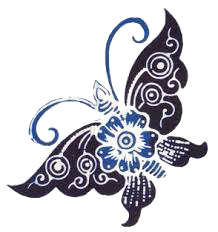Batik Tulis Lawasan Lasem Central Java
Definition of Batik Tiga Negeri A batik called three countries, famous in the coastal areas of Java, the patterns and colors are so complicated when viewed, makes people very difficult to remember the name of this batik. I knew the names of three countries when I explored batik in Cirebon. But in Lasem, I just understood why there is a batik cloth called three countries.
Batik of the three countries has an interesting philosophy. This batik depicts three cultures, namely the Dutch, Chinese, and Javanese cultures. The depiction of culture in this batik, is reflected in the colors used in batik. In the past, batik dyes came from plants, which made batik makers inevitably have to visit each area one by one.
In the three-country batik, the colors red, blue, brown/soga must always be present. In the past, the Lasem area (which was mostly inhabited by Chinese people) had an extraordinarily beautiful red color. This red color comes from the noni plant. As for the blue color, the batik makers chose the blue color produced by the Kudus area. This blue color is produced from a plant called Indigo. Then, the last color is brown which comes from the Soga plant which is found in the Surakarta/Solo area.
The colors red, blue and brown/soga, are colors that are always present in the batik of the three countries.
There is the Lasem area (which at that time was inhabited by many Chinese people) which has an attractive red (noni) color, the Kudus area for blue (indigo) and brown (soga) colors in the Surakarta area. It is said that in Lasem, the cloth of three countries was made in red, after that, the batik cloth brought to Kudus was made in blue and finally dyed with brown sogan, in the Surakarta area.
Ancient Batik or Batik Lawas or antique is batik that has been produced dozens to decades ago. The craftsmen initially made this batik just for personal collection, so the production was not much, no more than five pieces of cloth. Because it will be used for personal collection and there was no intention to sell it at first, so batik craftsmen pour their art as much as possible to design this batik motif.
It takes a long time to make one piece of personal collection of batik cloth, because batik craftsmen are also required to produce batik cloth that is indeed used for commercial purposes for the survival of their business. So that the process of making batik from a private collection is carried out in free time. Batik Lawasan Lasem
The resulting motif usually reflects the condition of the craftsman or the environment at that time, then applied to the batik motif according to the characteristics of the batik craftsman. There are batik craftsmen who have the characteristics of 'pethetan' or plants, so the motifs tend to be in the form of batik ornaments of flowers, leaves, roots, twigs, and stems. Another story with batik craftsmen who have 'sasatoan' characteristics, of course the motive will tend to be tame pets.
Readmore: Batik Tulis Lasem Becomes Souvenir at the G20 Summit
Ancient Batik which is a collection of batik, of course, will not be made as clothing by the craftsmen, although in fact the batik cloth can be made into clothes, so that this batik cloth will be displayed or only stored by the owner. Because it is only stored, the artwork from this batik collection cannot be enjoyed or known by others, so there is an intention to sell a collection of ancient batik fabrics so that the artwork of batik craftsmen is known by the wider community.
The price of ancient batik cloth is certainly not like ordinary batik cloth, because it has its own historical value from the batik craftsman. The price can reach a minimum of 7 digits. So don't even think about buying ancient batik collections, just to make clothes, because mathematically the price cannot be sufficient. Including if we do not have a hobby to collect ancient batik cloth, of course the price offered is clearly not included in the calculation.
For example, from the collection of ancient batik cloths or old batik as in the picture above, there has been a bid at the price of 1.5 million. However, because the cloth measuring 280 X 105 cm and not less than 23 years old has a high historical value, it cannot be removed and is still a private collection of the batik craftsman.


